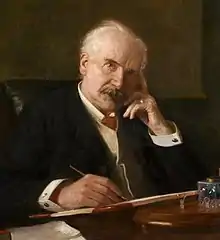Jesse Boot, 1st Baron Trent
Jesse Boot, 1st Baron Trent (2 June 1850 – 13 June 1931) transformed The Boots Company, founded by his father, John Boot, into a national retailer, which branded itself as "Chemists to the Nation".
The Lord Trent | |
|---|---|
 Boot in 1909 by Noel Denholm Davis | |
| Born | 2 June 1850 Nottinghamshire, England |
| Died | 13 June 1931 (aged 81) |
| Spouse(s) | Florence Anne Rowe |
| Children | Dorothy Florence Boot Margery Amy Boot John Boot, 2nd Baron Trent |
| Parent(s) | John Boot (father) Mary Wills (mother) |
Biography
Boot sold his controlling interest to American investors in 1920.
John Boot offered his close friend and business associate John Harston, the opportunity of going into business with him, but Harston declined, feeling the venture was not worth investing in.
Boot was a great benefactor to the City of Nottingham. He donated land for the new University College at Highfields, now the University of Nottingham, which opened in 1928 and was presented with the Freedom of the City of Nottingham in 1920. He was also a significant benefactor to his wife's home, Jersey.
Boot was knighted in 1909,[2] created a baronet in 1917,[3] and announced in the New Year's Honours of 1929 was elevated to the peerage, and created Baron Trent, of Nottingham in the County of Nottingham on 18 March 1929.[4] These latter honours probably owed as much to his solid support of the Liberal Party as to his philanthropy to the city of his birth.[5]

He died in Jersey in 1931. The Sir Jesse Boot Chair in Chemistry at the University of Nottingham was named in his honour. His widow commissioned the French glass artist René Lalique to refit the church of St Matthew, Millbrook (popularly known as the "Glass Church") as a memorial to him.
In 1935 a Primary school was built in Nottingham, Jesse Boot's home town. The School was titled The Jesse Boot Primary School and was located in Bakersfield, Nottingham. The School closed in 2009 after becoming an academy school.
His portrait, by Noel Denholm Davis, is in the collection of the University of Nottingham.[6] Another, by the same artist, is on loan to the National Portrait Gallery.[7]
Bibliography
- Jesse Boot of Boots the Chemist: A study in Business History by Stanley Chapman (Detail from a copy of the book with black and white plates of Jesse Boot and published by Hodder and Stoughton UK as a special edition for The Boots Company Nottingham in 1973 with an ISBN 0-340-17704-7.)
Arms
  |
|
References
- "Jesse and Florence Boot - theislandwiki". Theislandwiki.org. Retrieved 11 April 2018.
- "No. 28321". The London Gazette. 24 December 1909. pp. 9763–9764.
- "No. 29982". The London Gazette. 13 March 1917. p. 2512.
- "No. 33479". The London Gazette. 22 March 1929. p. 1968.
- Oxbury, Harold (1985). Great Britons: Twentieth-Century Lives. Oxford University Press. ISBN 978-0-19-211599-7.
- "Sir Jesse Boot (1850–1931), Bt, JP (later 1st Baron Trent)". Art UK. Retrieved 15 July 2014.
- "NPG L247; Jesse Boot, 1st Baron Trent". National Portrait Gallery. Retrieved 15 July 2014.
- Burke's Peerage. 1949.
External links
- Portrait by Noel Denholm Davis
- Biography – on Boots corporate website
- Boots family philanthropy – on Boots corporate website
- Chemists to the Nation – article in Pharmaceutical Journal
| Peerage of the United Kingdom | ||
|---|---|---|
| New creation | Baron Trent 1929–1931 |
Succeeded by John Campbell Boot |
| Baronetage of the United Kingdom | ||
| New creation | Baronet (of Nottingham) 1917–1931 |
Succeeded by John Campbell Boot |